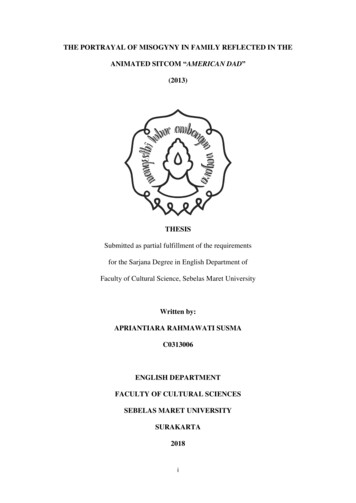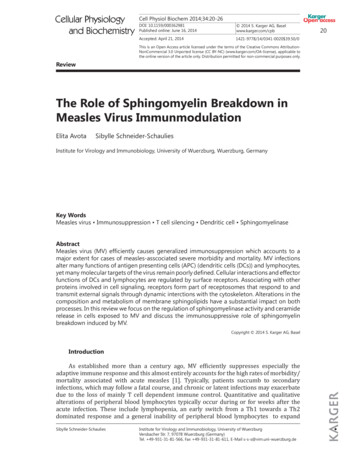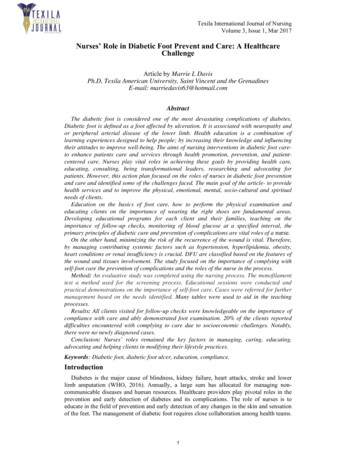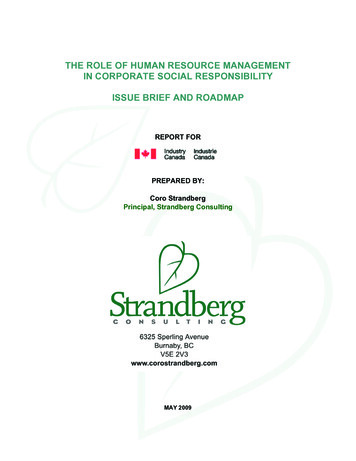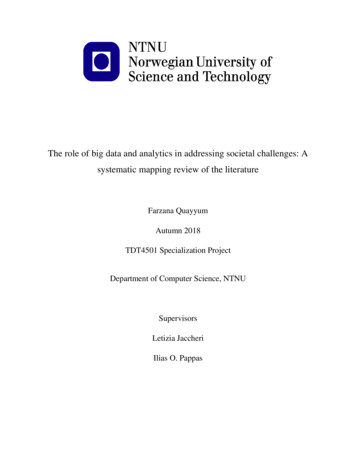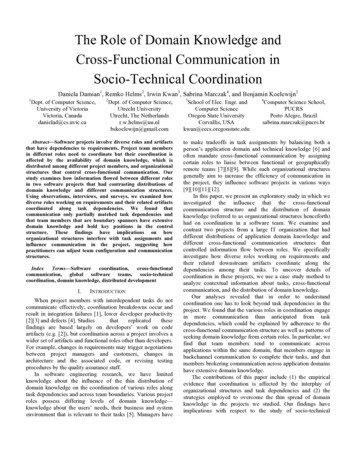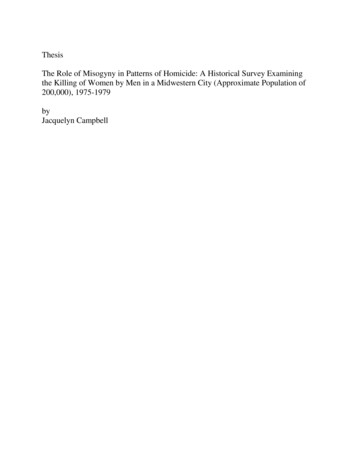
Transcription
ThesisThe Role of Misogyny in Patterns of Homicide: A Historical Survey Examiningthe Killing of Women by Men in a Midwestern City (Approximate Population of200,000), 1975-1979byJacquelyn Campbell
AbstractThe Role of Misogyny in Patterns of Homicide: A Historical Survey Examiningthe Killing of Women by Men in a Midwestern City (Approximate Population of200,000), 1975-1979Analysis of all cases of homicide involving women as victim and/or perpetrator in Dayton, Ohiobetween 1975 and 1979 showed that 71.9% of the intrasex killings between husbands and wives,boyfriends and girlfriends and estranged same, involved a prior history of wife abuse. Criticalanalysis of literature on violence from all perspectives, biological, psychological, sociological,anthropological and feminist, revealed the linkages of the concepts of machismo and misogynyto both forms of violence against women, homicide and wife abuse, as well as other gynocidalpractices. Women were shown to be generally non-violent both in national and cross culturalepidemiological studies on violence and homicide and in the Dayton homicide cases. When theydid kill, a significant proportion (49.1%) of the Dayton female killers were motivated by selfdefense, as compared to the 8.2% rate of victim precipitation when men killed women.Newspaper accounts of these cases were also analyzed showing some indication of theperpetuation of myths, subtle blaming of the victim, obsession with purity and sexism which isfound in the literature on other gynocidal practices. It is suggested that misogyny and machismogrow out of the patriarchal societal structure and that homicide of women along with wife abuseand other practices of violence toward females maintain the patriarchy by keeping womensubservient. Abused women were identified as a population highly at risk to kill or be killed andnursing intervention with these women suggested in terms of prevention.iiiLIST OF TABLES1. Homicides by District, Dayton, Ohio, 1974-1979 2332. City of Dayton Homicide Rates by Year in Comparison with Local UnemploymentPercentages and National Homicide rates 2383. Homicide Rates (Per 100,000 Population), Dayton, Ohio and National According to Raceand Sex 2414. Summary of Homicide Data, Dayton, Ohio 1968 through 1979 2455. Homicide Rate Per 100,000, City of Dayton, Ohio 1968 through 1979 2476. City of Dayton Homicide Data, Age and Race of Female Victims and Offenders 2487. Summary of Homicide Data, City of Dayton, Ohio Homicides Involving Females (19751979) 2538. Dayton, Ohio, Homicide Data, Homicides Involving Females, 1975 through 1979 2549. Homicide of Children in Dayton, 1975 through 1979 26910. Homicides of Men and Women without Prior Intimate Relationships 27011. Homicides of Men and Women in Intimate Relationships 273
ivDEDICATED TO:Lewis, for all his love, support and help and because he is one who cannot be accused ofmisogyny,Christy and Brad, who put up with and still love a mainly absent Mommy,Dorothy and Susan, for their love and support,Jo Ann and Peggy, for inspiration and pedagogy,Gert, for providing instigation and the standards to meet,My parents, for teaching me to love myself,Connie, for special help in time of great need,Other family and friends for caring in spite of extreme neglect,And to:Jocelyn, who was killed,Judie, Monica and Julie, who were beaten,And all other women who are in danger and can learn from this study.CHAPTER IINTRODUCTION AND PURPOSEOne of the ten national health priorities identified in the National Health Planning andDevelopment Act of 1974 is: "The promotion of activities for the prevention of disease,including studies of nutritional and environmental factors affecting health and the provision ofpreventive health care services."1 Homicide is defined as "the willful (non-negligent) killing ofone human being by another.2 In 1971, it was the leading cause of death for black women, age15-34 and the third highest cause of death for white women, age 15-29.3 In 1973, statistics listhomicide as the second leading cause of death in women aged 15-24 years.4 Homicide musttherefore be regarded as a major health problem of women which needs further study. It can beviewed as a disease of society which needs to be analyzed in that1 Joanne Hall and Barbara Weaver, A Systems Approach to Community Health(Philadelphia: J. B. Lippincott Company, 1977); p. 12.2 Marijian Herjanic and David Meyer, "Notes on Epidemiology of Homicide in a UrbanArea," Forensic Science 8 (November-December, 1976): 235-245, p. 237.
3 Leonide Martin, Health Care of Women (Philadelphia: J. B. Lippincott Company, 1978);pp. 8-11.4 Juanita Kreps, Social Indicators, 1976 (Washington, D.C.: U.S. Department of Commerce,1977); p. 195.12context in order to begin to identify the direction that primary prevention should take. Herjanicand Meyer state, "The development of meaningful preventive measures depends on repeatedepidemiologic investigations to determine the changes in pattern of crime."1 Therefore, homiciderates over time and associated demographic characteristics of the victim and perpetrator areappropriate objects of evaluation in order to formulate patterns and trends.The patterns of homicide must be studied in conjunction with an analysis of its roots in orderto provide a comprehensive paradigm on which to base preventive measures. Highriter calls fornursing research studies to combine descriptive analysis of statistics with theory in order toadvance community health nursing science.2 Pilisak and Ober demonstrate the need to viewviolence in a public health perspective, to conduct "inquiry into the distribution of the maladywithin the total population and into the facts about the social system that correlate with thisincidence."3 The missing element from most classic theories of violence is a thorough analysisof the role of misogyny (hatred of women). In 1977, of the 2,740 female homicide victimsnationally, 2,447 of the perpetrators were men.4 During the same year, of 8,565 men murdered,1,780 of the offenders were women, or in only 21% of the incidents.5 According to the City1 Herjanic and Meyer, p. 196.2 Marian Highriter, "The Status of Community Health Nursing," Nursing Research, 26(May-June, 1977), p. 190.3 Marc Pilisak and Lyn Ober, "Torture and Genocide as Public Health Problems," AmericanJournal of Orthopsychiatry, 46 (July, 1976): 388-392, p. 389.4 William H. Webster, Uniform Crime Reports, (Washington, D.C.: U.S. Department ofJustice, 1977), p. 9.5 Ibid.3of Dayton police reports, from a total of 70 homicides, 11 of the victims were women during theperiod of January 1, 1977 through December 31, 1977 in Dayton, Ohio. Of these murders ofwomen, ten of the perpetrators were male, one female. (Determined by physical evidence if notarrest and conviction of the murderer). In contrast, of the 59 men killed during that same period,only 13.6% (8) of the perpetrators were women. The predominance of men killing women overwomen killing men in both local and national statistics cannot be explained solely by attributingthe male predilection for violence to a biological tendency toward aggression, because of thecultures where the incidence of violence and homicide is almost nonexistent.1 Instead, theremust be a thorough analysis of the factors operating in our culture which leads to violence. Thepossibility that misogyny is operating when men murder women needs to be considered andexplored in a scholarly fashion. This kind of study is responsive to Grayce Sills' call for nursing
research that examines "the relationships of sexism, racism, poverty and other forms ofdeprivation to.health care."2In order to help determine the extent of misogyny in the Dayton area, the journalismregarding homicides as well as their actual patterns needs to be examined. As Suzanne Pingreeasserts, "media constantly provide us with symbolic messages about our cultural environment, .and relative importance of women and men."31 Erich Fromm, The Anatomy of Human Destructiveness (New York: Fawcett Crest, 1973),pp. 194-196.2 Grayce Sills, "Research in the Field of Psychiatric Nursing," Nursing Research, 26 (MayJune, 1977): p. 206.3 Susan Pingree, "A Scale for Sexism," Journal of Communications, 26 (1976): 193-200, p.198.4Susan Brownmiller points out that making the victim seem like she "asked for it" helps to lessenthe impact of the crime.1 There is often an obsession with the purity (of its lack) of the victim innewspaper accounts of female homicides.2 When the woman is portrayed as less than pure, thecrime is lessened, both in the opinion of patriarchal society and in its courts.3 This obsessionwith purity is found in the scholarly accounts (written mainly by men) of other male perpetratedgynocidal practices such as the Indian rite of suttee, or widow burning, and witch burning, aswell as in newspaper accounts of rape.4 Subtle blaming and obsession with purity of the victimcan be seen as part of an overall pattern of misogyny.Historical analysis of the patterns of homicide of women in Dayton, Ohio pluscomparisons of national and cross cultural statistics can therefore provide an indication ofpatterns and trends which may support the inclusion of misogyny as one of the roots of violencein our culture. Examination of the various newspaper accounts related to the Dayton homicidesfor evidence of sexism, obsession with purity and subtle blaming of the victim will also providedata to determine the presence of misogyny. Finally, a critique of selected theories of violencefrom all disciplines will provide a holistic background for the study. The theories will beanalyzed for identification of misogynous components, and the gaps where inclusion ofmisogyny would have made the theories more comprehensive will be identified.1 Susan Brownmiller, Against Our Will (New York: Simon and Schuster, 1975), pp. 387420.2 Betty Farrell, "The Court Said the Victims Invited the Trouble," New West (8/29/77):36-41, p. 38.3 Ibid.4 Mary Daly, Gyn/Ecology (Boston: Beacon Press, 1978), pp. 132-133.5BACKGROUND AND SIGNIFICANCESuzanne Steinmetz and Murray Straus attest that "any social pattern as widespread and
enduring as violence must have fundamental and enduring causes."1 In dealing with the aspect ofviolence in homicide of women, it is necessary to look at these causes. Biological, psychologicaland sociological factors need to all be considered as part of the roots of violence. Misogyny is aconcept which integrates all of these aspects, and yet has been absent from most theoriesregarding violence. In relationship to homicide of women, it is a theoretical framework thatneeds to be taken into account. Misogyny derives from our patriarchal social system which is anintegral part of the social forces that Steinmetz and Straus assert need to be understood, "becausemost aspects of violence, like most aspects of other human behavior, are the product of socialforces interacting with basic human potential.”2Patriarchy may be defined as "any kind of group organization in which males hold dominantpower and determine what part females shall and shall not play, and in which capabilitiesassigned to women are delegated generally to the mystical and aesthetic and excluded from thepractical and political realms."3 Patriarchy has been the predominant social form for all ofrecorded history, but there is growing archeolo1 Murray Straus, "Violence Research, Violence Control and the Good Society," Violence inOur Family ed. Suzanne K. Steinmetz and Murray Straus (New York: Harper and Row, 1974):321-324, p. 321.2 Suzanne K. Steinmetz and Murray Straus, "Intra Family Violence," Violence in the Familyed. Suzanne K. Steinmetz and Murray Straus (New York: Harper and Row,1974): 3-32, p.17.3 Adrienne Rich, On Lies, Secrets, and Silence (New York: W. W. Norton and Company,1979), p. 79.6logical and anthropological evidence that recorded history was preceded by more equitable ormatriarchal forms in which violence, in terms of human beings killing each other, was virtuallyunknown.1 These early cultural remnants show female deities, sharing in power and policymaking and natural divisions of labor based partially (although not entirely) on sex which werecomplementary and equally important.2The roots of the patriarchal societal organization can probably be most logically traced tomale fear of women because of the unexplained mystery of reproduction in primitive times.3There are thousands of legends from all parts of the world that indicate some crisis occurringwhen leadership was "wrested from the woman, either by force or seduction or both" between7500 B.C. and 1250 B.C.4 Early recorded history shows the efforts of men to overcome theirfear by establishing a religious basis for the subjugation of women and depreciation of thewoman’s role.5 Early Greek and Judaic patriarchal formations are based on the concepts ofsubjugation of nature and the1 Ruby Leavett, Peaceable Primates and Gentle People (New York: Harper and Row, 1975).2 Ibid. Toni Cade, "On the Issue of Roles," The Black Woman, ed. Toni Cade (New York:New American Library Inc.,,1970) pp. 101-112.3 Robin Morgan, Going Too Far (New York: Vintage Books, 1977) p. 309. Adrienne Rich,"Disloyal to Civilization: Feminism, Racism and Gynephobia," Chrysalis 7 (1979) :9-28, p. 16.4 Pat Robinson, et. al. "A Historical and Critical Essay for Black Woman in the Cities, June,
1969," The Black Woman, ed. Toni Cade (New York: New American Library, Inc., 1970), 198210, p. 203.5 Mary Daly, Beyond God the Father (Boston: Beacon Press, 1973), pp. 73-100. RosemaryRadford Ruether, New Woman, New Earth (New York The Seabury Press, 1975).7linking of male "essential selves with a transcendent principle beyond nature which is pictured asintellectual and male."1 Men eagerly accepted this paradigm and the "first oppressor-oppressedrelation, the foundation of all other class and property relations" became entrenched.2The patriarchal formulation was spread through religion, war, written history and economics.Each subsequent sociological and economic development further divided the sexes andsubjugated the female. Development of the patriarchal nuclear family structure and the control oftechnology by men have been the most lethal accomplishments of patriarchy for women.3 In thepresent world every avenue of power, military, industry, technology, government, science,finance, police, the courts and religion are almost entirely in male hands.4 However, the maleimage of aggression that stems from the patriarchal role assignments is beginning to be seen asdangerous to all human beings and is reflected in patriarchal class systems, attempts atcontrolling nature, and wars resulting in revolution, ecological pollution and widespreadviolence. Misogyny is embedded in patriarchy and is a basic part of the violence against womenin our society.The patriarchal social and economic system has resulted in rigid childbearing patterns wherethe mother has primary responsibility especially during the years before the child is capable ofrational thought. Since she is the person who can gratify all of the infant's1 Ruether, p. 13.2 Ibid, p. 3.3 Shulamith Firestone. The Dialectic of Sex (New York: William Morrow and Company,Inc., 1970).4 Kate Millet, Sexual Politics (Garden City, New York: Doubleday and Co., 1970): p. 25.8needs but sometimes does not, all human beings have a basic ambivalence toward femalefigures.1 The father represents the real and exciting world, and all boys are taught very early toreject their mothers and "join ranks with her oppressor.”2 Boys feel guilty about this desertionplus they fear the seeming omnipotence of the early mother.3The fear and guilt are translated unconsciously to hostility toward females generally.The unconscious hatred of women is nurtured and legitimatized by religion. From Eve towitches the Judao-Christian tradition depicts women as sinful.4 Mary is the only "holy" figurewho is female in Christianity, but she is "good" only in relation to Jesus.5 Since she is conceivedwithout sin and had a virgin birth, she becomes an impossible model for women to achieve.6Salvation is possible only through male figures.7 The church has set the example for misogynythrough early theological doctrine and witch burnings and the more recent stance againstreproductive control by women.8
1 Dorothy Dinnerstein, The Mermaid and the Minotaur (New York: Harper and Row, 1977),p. 60.2 Firestone, p. 58.3 Ibid. Dinnerstein, pp. 48-49.4 Daly, Beyond God the Father, p. 77.5 Ibid., p. 826 Ibid.7 Ibid.8 lbid., p. 63. Ruether, pp. 99 - 105.9Male self-esteem is based on the impossible model of invulnerability, perfect competence,fearlessness, virility, power and always winning.1 In order to bolster what must always be ashaky self-esteem when based on that image, religion and patriarchal parenting patterns havepresented the ideal scapegoat onto women, and they are consequently hated.2 Oppression ofwomen and other classes and/or races enhances the power of men and reinforces their tenuousself-esteem.When males feel that they are becoming powerless, violence is often the result.3 JacksonToby states that "violence may be the most appropriate way to protect one's honor, to showcourage or conceal fear, especially fear of revealing weakness.”4 In the lower social status themale is more likely to turn to violence because he is more impotent economically andpolitically.5 He is more likely also to claim authority on the strength of sex rank alone since he isusually forced to share more economic power with women.6 These factors are reflected in thehigher rates of homicide and violence among poor and black males.71 Marc Fasteau. The Male Machine (New York: McGraw-Hill, 1974).2 Daly, Beyond God the Father, p. 63.3 Rollo May. Power and Innocence (New York: W. W. Norton, 1972), p. 39. Jackson, Toby,"Violence and the Masculine Ideal: Some Qualitative Data," Annals of the American Academyof the Political and Social Sciences 364 (March, 1966): 19-28, p. 22.4 Toby, p. 22.5 May, p. 23.6 Millet, p. 36.7 Joan A. Kleba, "Homicide Trends in the United States, 1900-1974." Public Health Reports,90 (May-June, 1975): 195-204.10The most virulent form of male bravado is machismo. Machismo may be defined as a"doctrine that values sexual prowess, virility and power" above all else.1 This doctrine is actuallyprevalent in most males in most patriarchal societies, although it is usually described as being acharacteristic of the Hispanic culture and the lower classes. The machismo ethic rigidly defineswomen as property, adheres to the sexual double standard and glorifies violence, especially as anenforcement of the double standard.2 John Paddock studied two small towns ten miles apart inMexico which had basically the same socioeconomic and cultural backgrounds.3 One was
virtually free of homicide while the other had a high homicide rate. The major difference hefound was that "machismo was all but absent" in the non-violent community.4The sociologic conditioning of men and women which begins in the home and is continuedby the patriarchal society’s institutions further teaches and encourages the expression ofmisogyny. Boys are taught the male roles of competitiveness and aggression while girls areinstructed on how to accept their oppression and be victimized.51 Robert Brent Toplin, Unchallenged Violence (Westport, Connecticut: Greenwood Press,1975), p. 167.2 Ibid., p. 168.3 John Paddock, "Values in an Antiviolent Community," Humanitas, 12 (May, 1976):183194, pp. 183-184.4 Ibid., p. 191.5 Margaret Gates, "Introduction," The Victimization of Women, ed. Jane Chapman andMargaret Gates (Beverly Hills, California: Sage Publications, 1978), pp. 9-28.11Violence is often perceived tobe a natural extension of the male role, and misogyny is inherent inthe history lessons at school along with the unspoken message of the way women are treated bymen throughout the society.1 The school-aged boy is thought normal when he avoids girls andtalks openly of hating them. It may well be that this hatred, conceived in the parentingarrangements and male psyche, is somewhat repressed later by sexual necessity, as well as sexuallongings being repressed during this period.Exposure to literature, history and the media, conceived mainly by men, continues toreinforce misogyny and the sexual roles. Kate Millet has effectively shown how the patriarchalvalues and misogyny of our culture are revealed in the descriptions of the relationships betweencharacters of opposite sex in the novels of D. H. Lawrence, Henry Miller and Norman Mailer.2Written history has reinforced sex role stereotypes by selectively interpreting facts to make sexroles seem like the natural order, by negating the accomplishments of women by diminishingfemale historical works.3 Women are systematically discouraged from all creative endeavors andtheir literary and artistic works usually maligned by male critics.4 As Adrienne Rich maintains:"The ancient, continuing envy, awe and dread of the male for the female capacity to create lifehas repeatedly taken the form of hatred for every other female aspect of creativity.51 Millet, pp. 32-35.2 Ibid., pp. 190-230.3 Daly, pp. 132-133, Leavitt, pp. 10-18, Millet, p. 43.4 Rich, On Lies, Secrets, and Silence, p. 14.5 Ibid., p. 21.12The media is replete with sexism in print and advertising.1 Television's heroes are the perfectembodiment of the male image of aggression and virility complete with frequent acts of violenceagainst women.2 Exposure to violent television results in increased expressions of aggression in
free play and moral approval of aggressive solutions to problems, especially in boys.3 Theseoutgrowths of the patriarchal system serve to reinforce and continue misogyny.In modern society, "psychoanalysis has become the chief tool, replacing patriarchal religion,for rationalizing and sanctifying the inferiority of women."'4 Psychoanalytic theory starting withFreud has strengthened misogyny by accepting the idea that women are naturally defective andpostulating that any woman who rebels against a stereotyped role is mentally ill and needs to becast out by society or "cured" by the patriarchal figure of the psychiatrist.5 In the psychoanalytictradition mothers are blamed for most psychiatric ills, and yet motherhood is the only acceptablerole for women.6 By basing female psychology on "penis envy," Freud bolsters the idea thatwomen1 Pingree, p. 194.2 George Gerbner et. al. "Cultural Indicators: Violence Profile 09" Journal ofCommunication, 28 (Summer, 1978): 196-207.3 Margaret Thomas and Ronald Drabman, "Effects of Television Violence on Expectationsof Others' Aggression," Personality and Social Psychology 4 (Winter, 1978):73-76, p. 76.Gerbner, et. al., p. 203.4 Ruether, p. 137.5 Daly, Gyn/Ecology. pp. 223-292.6 Rich, On Lies, Secrets, and Silence, pp. 215-222.13are inferior and therefore worthy of contempt.1 If little girls envy boys, it is their eventualsuccession to the elevations of prestige and power that girls see occupied by men that is envied,not their biology.2 Thus, psychoanalytic theories and treatment have served men by legitimizingfurther the oppression of women and contributed to their hatred of the female sex.Homicide of women is only one of the expressions of misogyny.Susan Brownmiller has documented the history of rape as an expression of hatred and "aconscious process of intimidation by which all men keep all women in a state of fear."3 This fearserves to reinforce the patriarchal society. The study of rape and rapists has led to the conclusionthat it is a crime of violence rather than of passion.4 The attitudes of the rapists and police reflectthe subconscious attitude of male society, that there is very little wrong with violence againstwomen.5Mary Daly has documented other violent practices against women in history and acrosscultures as expression of misogyny.6 Indian suttee, witchburning, African genital mutilation,Chinese footbinding and western medical gynecology are all examples of institutionalized,1 Millet, p. 179.2 Firestone.3 Brownmiller, p. 5.4 Donna Schram, "Rape," The Victimization of Women, ed. Jane Chapman and MargaretGates, (Beverly Hills, California: Sage Publications, 1978), 53-57, p. 55.5 Ibid., p. 70.6 Daly, Gyn/Ecology.
14rationalized, male instigated forms of sadistic and horrible violence against women.1 One shouldnot fail to recognize that human beings who are guilty of such horrors against other humanbeings must feel hatred toward the other group.Closer to our present reality is the male perpetrated wife abuse which is only just beginningto be documented and fully examined. The patriarchal system which defines women as propertyof their spouses allows wife beating as an extension of that privilege. Del Martin delineates thehistory of wife abuse as a lawful privilege of the husband until the late 1800's and as anunofficially sanctioned practice today.2 The basic hated of women that underlies such practicesis brought out in the attitude of most wife beaters, that she deserved it.3 Wife abusers aregenerally men who feel inadequate in some way and need to physically dominate their wives.4Again the shaky male self-esteem that needs to be reinforced by oppression over others andwhich hates the female characteristics that are so much feared in itself, is operating.The wife battering syndrome is part of the homicide problem. "Family trouble calls" aredefined by the Dayton Police Department to be summons of aid from police from a neighbor orsomeone in the household1 Ibid.2 Del Martin, Battered Wives, (San Francisco: Glide Publications, 1976).3 John O'Brian, "Violence in Divorce Prone Families," Violence in the Family, ed. SuzanneK. Steinmetz and Murray A. Straus, (New York: Harper and Row, 1974), 65-74, p. 68.4 Robert Whitehurst, "Violence in Husband Wife Interaction” Violence in the Family, ed.Suzanne K. Steinmetz and Murray A. Straus, (New York: Harper and Row, 1974) 75-81, p. 76.15because of violence in the home. A call to police because of wife abuse would come under thisheading. A preliminary examination of Dayton Police Department homicide figures during theyear 1977 revealed that of 4 women killed by their husbands, two of the households had beeninvolved in "family trouble calls" during the previous year. One third of the women killed inCleveland area in 1975 were murdered by their spouse.1 These kinds of figures are substantiatedin other epidemiological studies of homicide.2 Wife abuse and murder of wives by their spouseis part of the patriarchal system which grants husbands absolute power over their wives.3 Wifeabuse needs to also be seen in terms of misogyny, and homicide of wives by their husbands asthe final extension of that hatred.4 Determining the number of women homicide victims whowere seen previously by the Dayton Police Department in connection with "family trouble calls"and examining the police homicide files for indication of wife abuse would help delineate thisconceptualization.The black woman is the most oppressed victim of patriarchy. Victim of double prejudice,that against women and that against the negro race, she is in an especially vulnerable position.The black liberation movement has been partially stymied because its male leadership1 Herjanic and Meyer, p. 240.2 Edward Green and Russell Wakefield, "Patterns of Middle Class Violence," TheJournal of Criminal Law and Criminology, 70 (Summer, 1979):172-181, p. 178. Harwin L. Voss
and John R. Hepburn, "Patterns in Criminal Homicide in Chicago," The Journal of CriminalLaw, Criminology and Political Science, 59 (December, 1968) 499-508, p. 506.3 Martin, p. 67.4 Rich, On Lies, Secrets, and Silence, p. 15.16continued the patriarchal male fallacy of defining themselves in terms of machismo.1 In theirquest for power, too many black men have emphasized the role of oppressor toward blackwomen, emulating their oppressor, white men.2 They have insisted that the only role of womenin black liberation is that of the supportive wife and mother.3 The myth of the black matriarchywas invented by a white man and resulted in further division of the black sexes as well as furtherderogation of the black race.4 Black women have been discouraged from joining the feministmovement by their men and by the imitative prejudice of white women.5 Divide and conquer isone of the best friends of patriarchy.Many black men are in an extremely volatile position. They need to culturally definethemselves in terms of power, yet are kept from economic and political power by the white malehierarchy. Their feelings of impotence often are expressed in violence. Because of patriarchallylearned misogyny, that violence is often directed towards black women.6 "Her head is moreregularly beaten than any other woman's, and by her1 Michelle Wallace, Black Macho and the Myth of the Super Woman, (New York: The DialPress, 1978), pp. 32-33.2 Frances Beale, "Double Jeopardy: To Be Black and Female," The Black Woman (NewYork: New American Library, Inc., 1970), pp. 90-100. Paul Freire, Pedagogy of the Oppressed(New York: Herder & Herder, 1972), pp. 29-30. Wallace, p. 29.3 Abbey Lincoln, "Who Will Revere the Black Woman?" The Black Woman, ed. Toni Cade(New York: New American Library, Inc., 1970): 80-84. Wallace, p. 106-107.4 Wallace, pp. 109-110.5 Rich, On Lies, Secrets, and Silence, p. 303.6 Ibid., p. 284.17own man; she's the scapegoat for Mr. Charlie."1 Black women are killed three times as often aswhite women.2 There has been "limited previous treatment of violence as a cause of deathamong women," and "the literature on black women in this area is virtually nonexistent."3This study will attempt to rectify this situation, at least partially.There is indication from the study of anthropology and sociology that non-patriarchal or lesspatriarchal societies may have lower rates of violence than ours.4 There are remnants
15-34 and the third highest cause of death for white women, age 15-29.3 In 1973, statistics list homicide as the second leading cause of death in women aged 15-24 years.4 Homicide must therefore be regarded as a major health problem of women which needs further study. It can be viewed a
